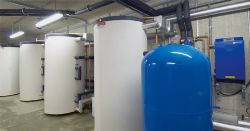As demand for solar hot water systems becomes greater, the question arises as to how such systems protect human health from Legionnaires' Disease. Kevin Potter explores the options
Legionnaires' Disease is a potentially fatal form of pneumonia which can affect anybody. The illness is normally contracted by inhaling legionella bacteria deep into the lungs, either in tiny droplets of water (aerosols), or in droplet nuclei (the particles left after the water has evaporated) contaminated with the infection.
With 200 to 250 reported cases of Legionnaires' Disease each year in the UK, it is vital when considering the application of solar thermal systems that the equipment used is designed to ensure protection against the proliferation of legionella bacteria, while at the same time still making the most efficient use of potential solar energy gained.
Research shows that legionella bacteria breeds at its most prolific in water temperatures between 20 and 45 deg C. It is also known that at 60 deg C, over 90 per cent of the bacteria is killed within a few minutes, while at 50 deg C it would take several hours to achieve the same level of elimination.
Pasteurise dailyThe HSC document L8 is the approved code of practice and guidance for the control of legionella bacteria in water systems. It states that pasteurising should occur daily, for a minimum period of one hour at 60 deg C to ensure elimination of any legionella bacteria.


Traditionally, cylinders are designed to allow hot water to stratify during normal operation, with the hottest water at the top of the cylinder, the cold water feed towards the bottom, and the system return in between. During the anti-legionella cycle, it is essential that the cylinder is mixed evenly to the minimum 60 deg C temperature, using a de-stratification pump.
In a solar hot water system, lukewarm water could remain for several days in the storage vessel, which may suggest a greater risk of legionella bacteria contamination. Yet, with a better understanding of how a solar thermal solution operates throughout the year, the risk posed by the hazardous bacteria can be minimised.
There will be periods during the year when there is not enough solar irradiation to heat the water in the solar cylinder to the required temperature of 60 deg C. During the winter for instance, the reduction in solar irradiation can mean that as little as only 20 per cent of the hot water demand temperature is available using solar energy, requiring other heating appliances, such as gas fired boilers or water heaters, to ensure the required temperature is reached to eliminate legionella.
In summer, providing the system as been designed correctly, there can be sufficient solar energy to meet the required demand without support from auxiliary heat inputs. During these periods, the risk of legionella developing is greatly reduced. However, like other DHW solutions, there will be a need to pasteurise the solar cylinder at the correct temperature to further minimise the risk of bacterial contamination.
There is a choice of control philosophies for solar hot water and anti legionella; using the programme available within the solar controller; using the auxiliary heat controller; or using a building management system (BMS) to undertake the control of the task.
Again, there is a choice of when is best to program the anti-legionella function. Ideally, the anti-legionella cycle should be set to run out of normal hours, at a time when there is little or no water draw off, which will allow the cylinder to heat up quickly.
Alternatively, if solar energy is to be used, this will be during daylight hours when many buildings will be occupied and in use.
In twin-coil solar cylinders for instance, the lower coil is heated by the solar collector array and the top coil by the auxiliary heating appliance. A temperature sensor is required in the solar cylinder to measure the water temperature.
The timed anti-legionella cycle should initiate the de-stratification pump to mix the stored water to an even temperature. In most cases, it will be necessary to reheat the water as the mixing occurs, and to maintain the temperature at 60 deg C for a minimum of one hour. If solar energy is available during the cycle, this can be used to heat the water at no cost. However, if there is insufficient solar energy, then the auxiliary heat source will supply the heat input.
Where solar energy is used with multiple cylinders or as a feed to a direct-fired water heater, a loading pump will be used between vessels, and this must be operated to ensure all vessels are heated to 60 deg C during the anti-legionella cycle.
Protection of the building occupants, their welfare and safety are paramount, so DHW systems must be designed to comply with regulations for both anti-legionella and anti-scalding, being mindful of the high temperatures that can be found in the stored hot water.
TMVs used at point of use
Thermostatic mixing valves should be used to blend cold water close to point of use, to take account of the higher temperatures that can be generated through solar thermal solutions.
When considering the application of any hot water system, it is essential to take preventative measures against the risk of legionella. Yet, with a solar thermal solution extra consideration needs to be given to operating the necessary anti-legionella cycle using the most efficient and effective method. The elimination of legionella bacteria in solar thermal hot water systems should avoid wasting as much as possible the potential solar energy gained.
//The author is business development manager (DHW systems) at Hamworthy Heating //